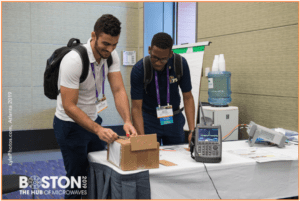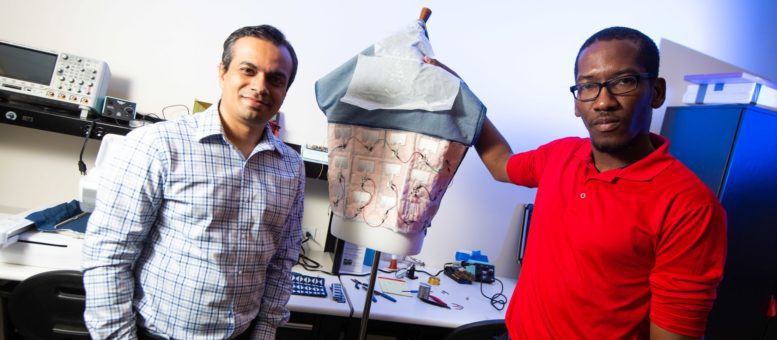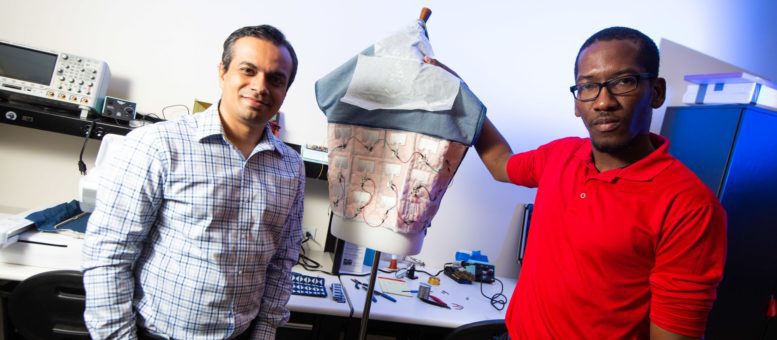Clothing is embroidered with designs and logos using a sewing machine and threads. Dieff Vital, an electrical and computer engineering doctoral student, is using the same sewing machine and conductive threads to embroider antennas and electronic circuits on regular clothing.
Why? Vital, a survivor of the catastrophic 2010 Haiti earthquake, is working on wearable antennas that will capture power to charge biosensors and help serve underserving communities to monitor their health without having to spend money at a hospital. For his research, Vital was one of 394 students and young professionals whose papers were selected from a worldwide pool of 783 applicants to attend the 2019 International Microwave Symposium.

Vital grew up in the small city of Torbeck in Haiti. He aspired to be an engineer and a surgeon, but quickly realized he wasn’t a fan of blood. Vital pursued an engineering degree at the State University of Haiti. On January 12, 2010, Haiti was struck with a devastating 7.0-magnitude earthquake. Approximately 250,000 lives were lost, including Vital’s older brother. The tragedy affected Vital immensely.
“I was not ready to lose my brother,” said Vital. “He wanted to become a priest.”
Two years later, Vital moved to the United States to start a new chapter. He attended Miami-Dade College and then transferred to Florida Polytechnic University, where he obtained a bachelor’s in mechanical engineering. In 2017, Vital began his doctoral studies at the College of Engineering & Computing’s RFCOM Lab, led by John Volakis, dean of the college. With the help of Volakis and Shubhendu Bhardwaj, assistant professor for the Department of Electrical and Computer Engineeringand Vital’s major advisor, the team brainstormed power harvesting for wearable applications.
Cell towers release wattage power for consumers to be able to receive signals on their cell phones. Each cell tower sends between 500 and 600 watts, but cell phones only receive a few microwatts or nanowatts. The rest of the power goes into the environment, all scattered. Vital is installing antennas on regular clothing to receive that extra power and convert it into usable power. The purpose of this power is to charge medical devices, like biosensors that can be used to detect and monitor diseases, or pacemakers.

Coming from the poorest country in the Western hemisphere, according to The World Bank, Vital has firsthand experience on how people who lack money suffer the most.
“You have a lot of people with critical health conditions dying,” he said. “For individuals with diabetes, wounds are a serious concern. They need to monitor their wound to see if it’s healing and most of the time this requires them to frequently visit hospitals. It costs money and most of these people are denied health care.”
Vital’s goal is to make the monitoring process for users more cost-effective. A smart bandage would be placed on a person’s wound and help them monitor it.
“Vital is an inspirational doctoral student who is using his expertise in power harvesting to make a difference in medically underserved communities,” said Bhardwaj. “His hard work is being noticed at top conferences and by professionals in the field of RF and microwave engineering.”
At the 2019 International Microwave Symposium, held in Boston, Massachusetts, Vital participated in the 3MT Competition. The competition consists of taking your entire research and explaining it to a non-technical audience in exactly three minutes. For this particular competition, 150 students applied and only 20 were selected to deliver their final presentations, where he received an honorable mention. Vital had a practice session with the conference’s organizers before his presentation.
“Explaining my technical activities to a non-technical audience was a bit of a challenge,” said Vital. “Luckily, I had the help of the conference organizers and one of them happened to have experience in theater. They showed me how to move my hands and keep the audience engaged.”
At the conference, Vital and Alfredo Gonzalez, another electrical and computer engineering doctoral student from FIU, won third place in the student design competition. They designed an affordable wearable power harvesting system that is as functional as a regular power harvester.

Vital also collaborated with two doctoral students from the University of California, Davis and the University of Central Florida. The three took two papers from the conference to come up with their own idea for a poster presentation – the designing and fabricating of a bra with an antenna that can help women detect breast cancer and potentially treat it as well.
The bra would work by incorporating an array of antennas and a harvesting modality in the bra. When the array of antennas is powered, the bra would map the whole breast and look for the tumor. The tumor would be localized and the array would focus on the particular location of the tumor to perform ablation. This is an effort to eliminate chemotherapy and avoid having the entire body be exposed to chemicals.
The IMS Conference is part of IMS Microwave Week, usually held in June, where more than 10,000 participants exhibit state-of-the-art microwave products. It is the world’s largest gathering of Radio Frequency (RF) and microwave professionals for the latest research advancements in the field of RF and microwave engineering.







